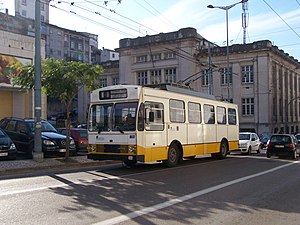Trolleybuses in Coimbra
| Coimbra trolleybus system | |
|---|---|
 | |
| Operation | |
| Locale | Coimbra, Portugal |
| Open | 16 August 1947 |
| Status | Open |
| Routes | 2[1] |
| Operator(s) | SMTUC |
| Website | SMTUC (in Portuguese) |
Urban transport in Coimbra | ||||||||||||||||||||||||||||||||||||||||||||||||||||||||||||||||||||||||||||||||||||||||||||||||||||||||||||||||||||||||||||||||||||||||||||||||||||||||||||||||||||||||||||||||||||||||||||||||||||||||||||||||||||||||||
|---|---|---|---|---|---|---|---|---|---|---|---|---|---|---|---|---|---|---|---|---|---|---|---|---|---|---|---|---|---|---|---|---|---|---|---|---|---|---|---|---|---|---|---|---|---|---|---|---|---|---|---|---|---|---|---|---|---|---|---|---|---|---|---|---|---|---|---|---|---|---|---|---|---|---|---|---|---|---|---|---|---|---|---|---|---|---|---|---|---|---|---|---|---|---|---|---|---|---|---|---|---|---|---|---|---|---|---|---|---|---|---|---|---|---|---|---|---|---|---|---|---|---|---|---|---|---|---|---|---|---|---|---|---|---|---|---|---|---|---|---|---|---|---|---|---|---|---|---|---|---|---|---|---|---|---|---|---|---|---|---|---|---|---|---|---|---|---|---|---|---|---|---|---|---|---|---|---|---|---|---|---|---|---|---|---|---|---|---|---|---|---|---|---|---|---|---|---|---|---|---|---|---|---|---|---|---|---|---|---|---|---|---|---|---|---|---|---|---|
| ||||||||||||||||||||||||||||||||||||||||||||||||||||||||||||||||||||||||||||||||||||||||||||||||||||||||||||||||||||||||||||||||||||||||||||||||||||||||||||||||||||||||||||||||||||||||||||||||||||||||||||||||||||||||||
The Coimbra trolleybus system (Portuguese: Rede de Tróleis de Coimbra) forms part of the public transport network in the city of Coimbra, Portugal. Opened in 1947, it supplemented, and then eventually replaced, the Coimbra tramway network.
History
Trolleybus traffic was inaugurated in Coimbra on 16 August 1947 with two Saurer 3TP trolleybuses.
Initially, the trolleybus system only partially replaced Coimbra's tramway network, but after several decades of concurrent operations the latter was closed, in January 1980.
Until 1959, the Coimbra trolleybus system was the only one in Portugal. Since the closure of the Porto system in 1997, that has again been the case.
Lines
The system currently has two lines.
Fleet
Past fleet
The initial two member Saurer fleet was augmented in 1949, with the acquisition of six new buses from Sunbeam Commercial Vehicles. The vehicles supplied were based on Sunbeam's MF2B model, with two axles and a wheelbase of 16.25 feet (4.95 m). They were fitted with single deck bodywork by Park Royal Vehicles, with 40 seats and room for 35 standing passengers. In order to enable them to be operated by just the driver, they included an overhang of 8.25 feet (2.51 m) beyond the front axle, allowing the entrance door to be mounted just behind the windscreen, so that payment could be made to the driver when entering the vehicle. To cope with the steep gradients of the Coimbra system, they were fitted with 125 horsepower (93 kW) 600-volt motors, and each trolleybus carried two compressors, normally designed to work together, but each capable of maintaining the air supply for braking and door operation if one should fail.[2] Three more Sunbeam Park Royals joined the fleet in 1956.
Subsequent procurements included 10 BUT RETB/1s (four in 1958 and six in 1961), and six further Sunbeams in 1965.[3]
Current fleet
Today, the Coimbra trolleybus fleet is as follows:[3]
- 10 conventional (two axle) Caetano/EFACEC vehicles, built between 1984 and 1986;
- 1 secondhand conventional Caetano/EFACEC trolleybus (with auxiliary diesel engine), borrowed from the closed Porto system;
- 1 conventional Solaris Trollino, delivered in 2009.
Future fleet
- 6 Van Hool ExquiCity dual-mode buses to be delivered in 2020.
See also
References
References
- ^ "Trolleybusstadt: Coimbra Portugal". Trolley: Motion. Archived from the original on 14 September 2016. Retrieved 31 August 2016.
- ^ "British trolleybus debut in Portugal". Commercial Motor. 25 August 1950. p. 34.
- ^ a b "Vehicles list: Coimbra, trolleybuses". transphoto.ru. Retrieved 7 September 2011.
Books
- Groneck, Christoph (2008). Metros in Portugal – Schienennahverkehr in und um Lissabon und Porto [Metros in Portugal – Suburban rail transport in and around Lisbon and Porto] (in German). Berlin: Robert-Schwandl-Verlag. ISBN 978-3-936573-20-6.
External links
![]() Media related to Trolleybuses in Coimbra at Wikimedia Commons
Media related to Trolleybuses in Coimbra at Wikimedia Commons
- Coimbra trolleybuses (on the Trolleymotion website)
- Coimbra database / photo gallery and Coimbra trolleybus list at Urban Electric Transit – in various languages, including English.

